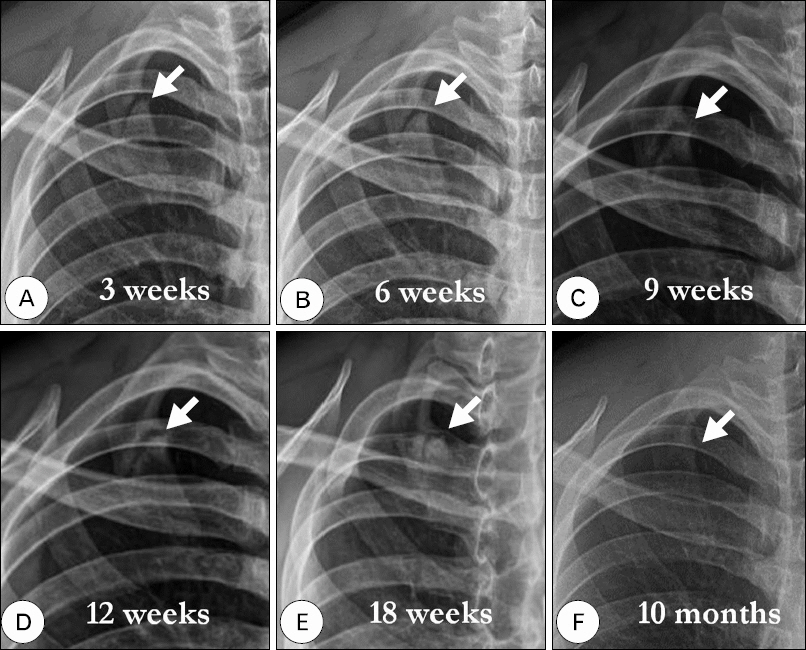Korean J Sports Med.
2020 Jun;38(2):117-120. 10.5763/kjsm.2020.38.2.117.
First-Rib Fracture in a Baseball Pitcher
- Affiliations
-
- 1Department of Orthopaedic Surgery, Good Samsun Hospital, Busan, Korea
- KMID: 2502524
- DOI: http://doi.org/10.5763/kjsm.2020.38.2.117
Abstract
- First-rib fractures may be caused due to high energy direct trauma, violent muscle contracture, or chronic fatigue. Isolated fractures are very rarely noted and may be a potential cause of nonspecific shoulder pain in overhead athletes. Although the exact mechanism underlying first-rib fractures caused by sudden muscular contracture is still not known, many repetitive activities have been associated with with these unique fractures. We present a case of an acute first-rib fracture in a rookie professional baseball pitcher. He returned to the same level of throwing in 5 months with rest and rehabilitation.
Keyword
Figure
Reference
-
1. Coris EE, Higgins HW 2nd. 2005; First rib stress fractures in throwing athletes. Am J Sports Med. 33:1400–4. DOI: 10.1177/0363546505275349. PMID: 16002484.
Article2. Sakellaridis T, Stamatelopoulos A, Andrianopoulos E, Kormas P. 2004; Isolated first rib fracture in athletes. Br J Sports Med. 38:e5. DOI: 10.1136/bjsm.2003.009225. PMID: 15155456. PMCID: PMC1724847.
Article3. Lankenner PA Jr, Micheli LJ. 1985; Stress fracture of the first rib: a case report. J Bone Joint Surg Am. 67:159–60. DOI: 10.2106/00004623-198567010-00022. PMID: 3968096.
Article4. Matsumoto T, Fujita K, Fujioka H, et al. 2003; Stress fracture of the first rib in a soccer player: a rare etiology of shoulder pain. J Shoulder Elbow Surg. 12:197–9. DOI: 10.1067/mse.2003.22a. PMID: 12700577.
Article5. Kim JB, Hong S. 2017; Bilateral first rib stress fractures with pseudoarthrosis in a young weightlifter: a rare cause of shoulder pain. Korean J Sports Med. 35:121–4. DOI: 10.5763/kjsm.2017.35.2.121.
Article6. Lorentzen JE, Movin M. 1976; Fracture of the first rib. Acta Orthop Scand. 47:632–4. DOI: 10.3109/17453677608988750. PMID: 1015257.
Article7. Curran JP, Kelly DA. 1966; Stress fracture of the first rib. Am J Orthop. 8:16–8. PMID: 5903797.8. Luceri RE, Glass NE, Bailey JA, et al. 2018; First rib fracture: A harbinger of severe trauma? Am J Surg. 216:740–4. DOI: 10.1016/j.amjsurg.2018.07.034. PMID: 30060914.
Article9. Funakoshi T, Furushima K, Kusano H, et al. 2019; First-rib stress fracture in overhead throwing athletes. J Bone Joint Surg Am. 101:896–903. DOI: 10.2106/JBJS.18.01375. PMID: 31094981.
Article10. Young BL, Watson SL, Meyer RD, Ponce BA. 2016; Nonunion of first rib fracture in a softball player: case report of a rare cause of thoracic outlet syndrome. J Shoulder Elbow Surg. 25:e353–7. DOI: 10.1016/j.jse.2016.07.025. PMID: 27742249.
Article
- Full Text Links
- Actions
-
Cited
- CITED
-
- Close
- Share
- Similar articles
-
- A Case of Throwing Fracture of the Humerus in a Amateur Baseball Pitcher
- Little Leaguer Shoulder with Contralateral Thrower's Fracture of the Humerus in Adolescent Baseball Pitchers
- Scapulothoracic Bursitis in a Amateur Baseball Pitcher
- Intra-Apophyseal Avulsion Fracture of Medial Epicondyle in a Adolescent Baseball Player
- Atypical Spondylolysis of the Fifth Lumbar Vertebra in Baseball Players: Two Cases Report




